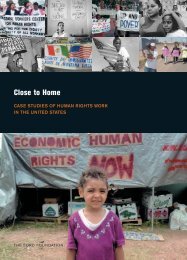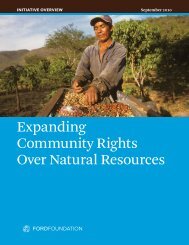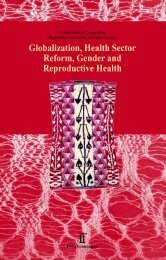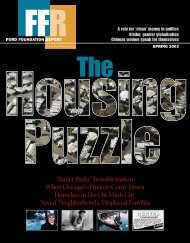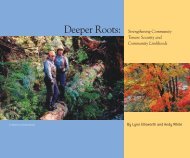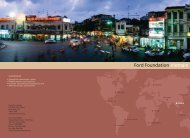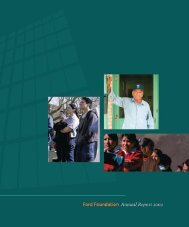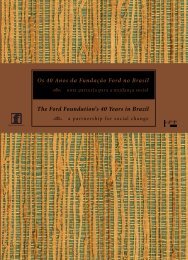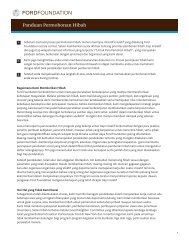Inclusive Scholarship: Developing Black Studies - Ford Foundation
Inclusive Scholarship: Developing Black Studies - Ford Foundation
Inclusive Scholarship: Developing Black Studies - Ford Foundation
You also want an ePaper? Increase the reach of your titles
YUMPU automatically turns print PDFs into web optimized ePapers that Google loves.
<strong>Inclusive</strong> <strong>Scholarship</strong>: <strong>Developing</strong> <strong>Black</strong> <strong>Studies</strong> in the United States 31<br />
tion only supported the belief that standards were being lowered to admit<br />
<strong>Black</strong> students who were bound either to fail or to undermine the quality<br />
of education. The new <strong>Black</strong> assertiveness could only antagonize those who<br />
held to the ideal of integration and of a color-blind system of merit. <strong>Black</strong><br />
students were, in their view, racists who merely wanted to turn an evil on<br />
its head. Antagonism over these issues set the tone for the debate over <strong>Black</strong><br />
<strong>Studies</strong> when it became a central issue, and it also affected the reception of<br />
these programs when they were established by the end of the decade.<br />
Forthemostpart,negotiationswentquietly.CollegeslikeBowdoin,Carleton,<br />
Macalester, and Dartmouth, removed from crosscurrents of student<br />
radicalism, were able to move at their own pace to increase <strong>Black</strong> enrollment,<br />
appoint <strong>Black</strong> faculty and staff,and introduce a few courses on topics of interest<br />
to Afro-Americans. 14 In some conspicuous instances, however (Cornell,<br />
San Francisco State,Wesleyan),the students armed themselves,and the threat<br />
of riot and violence was quite real.At other institutions, calls for <strong>Black</strong> <strong>Studies</strong><br />
courses and programs merely added to a general atmosphere of conflict and<br />
upheaval.Tothemostvociferousactivists,Afro-Americanacademicprograms<br />
were likely to be of incidental or secondary importance; what they were really<br />
interested in was not an academic but a political revolution.<br />
San Francisco State University<br />
On September 29, 1968, the trustees of the California State College System<br />
voted 85 to 5 to fire one G. M. Murray from his post as an untenured lecturer<br />
at San Francisco State College. Murray, a member of the <strong>Black</strong> Panthers, had<br />
been hired as part of an attempt to increase <strong>Black</strong> faculty; he had been teaching<br />
courses that were, according to Murray, “related to revolution.” The firing<br />
set in motion a series of shocks to the campus, including student strikes,<br />
violence from civilians and police, the closing of the school, and the final enforcement<br />
of order under the newly appointed president, S. I. Hayakawa.<br />
The institution came as close to anarchy as one could possibly imagine,<br />
with college faculty and students, the mayor and citizens of San Francisco,<br />
Governor Ronald Reagan, and President Hayakawa engaged in strategies<br />
alternating between charges, threats, demands, the use of violence, naked





